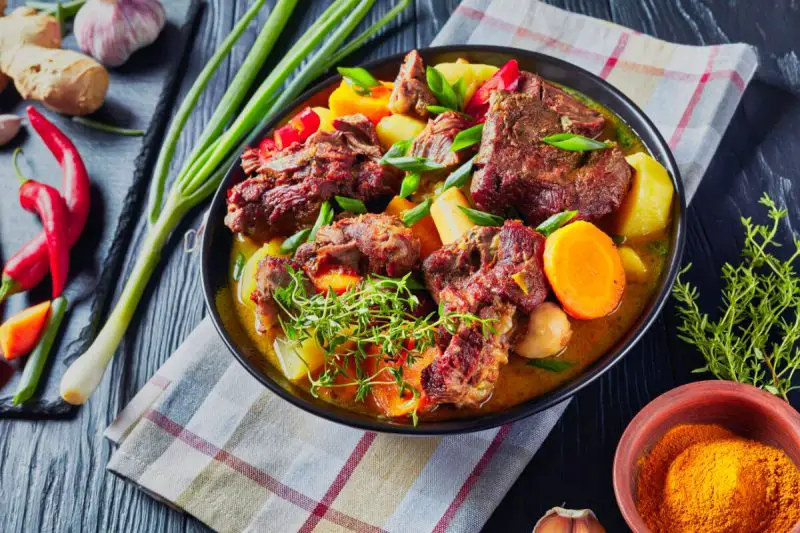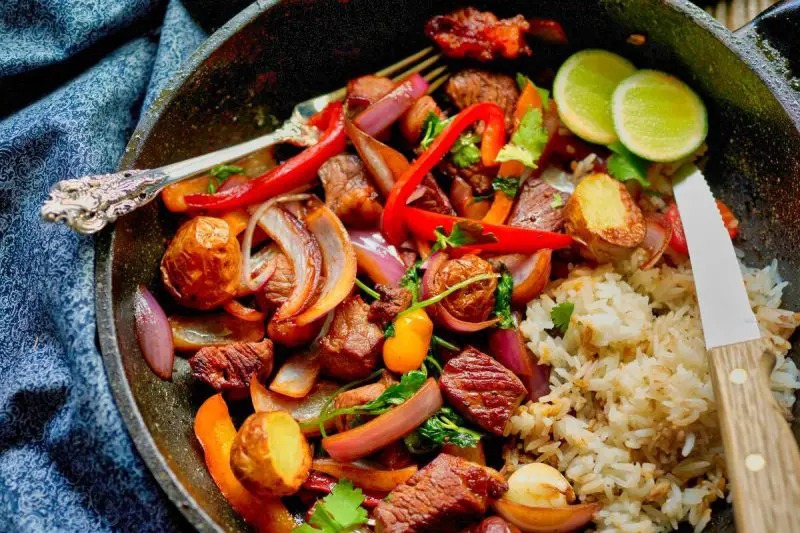Traditional Hungarian food forms the basis of what is known as modern-day Hungarian Cuisine. From Goulash to Hungarian Desserts, seasonal vegetables, meats, bread, cheeses, and dairy products are the main staples of the Hungarian Cuisine.
Traditional Hungarian Cuisine
Hungary, as a country, is rich in culture and tradition. Bread is and has been important in Hungarian food culture and diet. It is a part of almost all the meals in the country. Before the communist regime fell, white bread was the staple food of the region. Ever since then, there has been a proliferation of innovative pastries and baked Hungarian dishes.
Hungarian cuisine and food facts tells us that Hungarian cuisine is heavily influenced by Magyar culture. Additionally, it is also influenced by continental central European culture, though certain elements trace their origin from Eastern Europe. Poppy is a good example of the latter and is quite popular in Hungarian food. Additionally, kefir and quark also are cooking elements from eastern Europe.
Meats and cheeses are common elements in Hungarian food. Pork, chicken, and beef are the most common, while duck, turkey, fish, and game meat are mostly used on special occasions. In Hungary, sausages and salamis are relatively inexpensive since there is a lot of pork production.
The History of Hungarian Dishes
The prominence of meat in Hungarian cuisine directly traces its origins from the nomadic and livestock-keeping culture of the Magyar people. This is also reflected in Hungarian traditional food, such as the famous Goulash, which means cattleman’s meat. Another traditional food, the halaszle, a spicy fisherman, soup, is cooked in open fire cauldrons, as is the goulash.
The renaissance also had a huge effect on the cooking practices of Hungarian Recipes. Hungarian food history shows that it led to the introduction of things such as mace, saffron, garlic, and nutmeg. However, some of the spices, like saffron and garlic, are no longer used.
Hungary was an integral member of the Austro-Hungarian empire. Thus, it is no surprise that there are many food preparation methods and dishes that have been borrowed from Austrian cuisine. An example of this can be seen in certain cakes and sweets in Hungarian Desserts with strong German influences.
The foods and dishes present in Hungarian cuisine result from Hungary itself being a melting pot of Europe and holding its own in the Magyar culture.

Old Style Hungarian Food Preparation
Since past times, it is common for all the main Hungarian dishes to have a side dish, which is referred to as koret. Though you can offer the main dish without the side dish, it is very uncommon, as it is unusual to violate the conversation.
Some of the foods have a customary side dish to accompany it .An example of this is paprika chicken, which is always eaten with noodles, though some also use fried cheese.
Hungarian food is characterized by desserts, pastries, soups, and casseroles. However, most dishes are generally common to the entire region. That being said, there are usually nuanced differences between the method of preparation and presentation of the same dishes in different regions, and this has caused fierce rivalries.
Take, for example, a fisherman’s soup dish, known as Halaszle. For many years, and even right now, it is cooked differently on the banks of Hungary’s two main rivers; the Tisza and the Danube.
Smoking was the main way to cook pork and other types of meat, both game and domestic. A smoky taste characterized the foods and dishes. Smoked ham, sausages, and lard were consumed after smoking and no other preparation or presentation. Fresh vegetables and bread accompanied them. These same dishes are even today offered as starters in hotels and restaurants.
Pickled, or fermented vegetables are also another staple of old traditional Hungarian food. The most common of the said vegetables is sour cabbage, known as savanyu Kaposzta, and sour peppers. Alternatively, the Hungarians also used a mix of cauliflower, baby watermelon, green tomatoes, and other vegetables. They used to consume these vegetables mainly during the winter season, and they are the main source of vitamin ‘c’ during that season.

Modern Hungarian Recipes and Dishes
Like many cuisines worldwide, the modern Hungarian cuisine has its foundations deeply entrenched in old, traditional cooking methods and foods. Thus, you will find a plethora of dishes that have more or less remained the same, from their preparation to presentation and consumption, throughout hundreds of years.
This is facilitated by the entire culture actively trying to pass the traditions from one generation to another. Sous chefs will pass the perfected recipes and pass them onto novice chefs, and mothers will do the same with their children.
This is not to say that creativity and ingenuity in the kitchen are harbored. Quite the contrary. Over the last couple of years, Hungarian chefs have begun to incorporate creativity into their cooking and presentation to success.
Most of the Hungarian food recipes, dishes and foods prepared in modern-day restaurants, eateries and hotels acquiesce to today’s cooking standards. Thus, most of the said dishes become so unusual and unfamiliar to native Hungarians because they are used to prepare their meals using traditional methods.
Since bread is a staple of the Hungarian diet, modern bakeries have been set up worldwide. Now, the Hungarians can buy freshly baked bread every other day from the local bakery.
Traditional Hungarian food is healthy, whether you are a resident of Hungary or a visitor you can enjoy the traditional Hungarian food whether it has been prepared and cooked traditionally or in a modern way. For example, you can start your day with bakery products, served along with meat and heavy soups. Get to know that most Hungarian foods are spiced and it is the amount of spice in them that brings a difference between the Hungarian food and the Slavic Nations’ food.
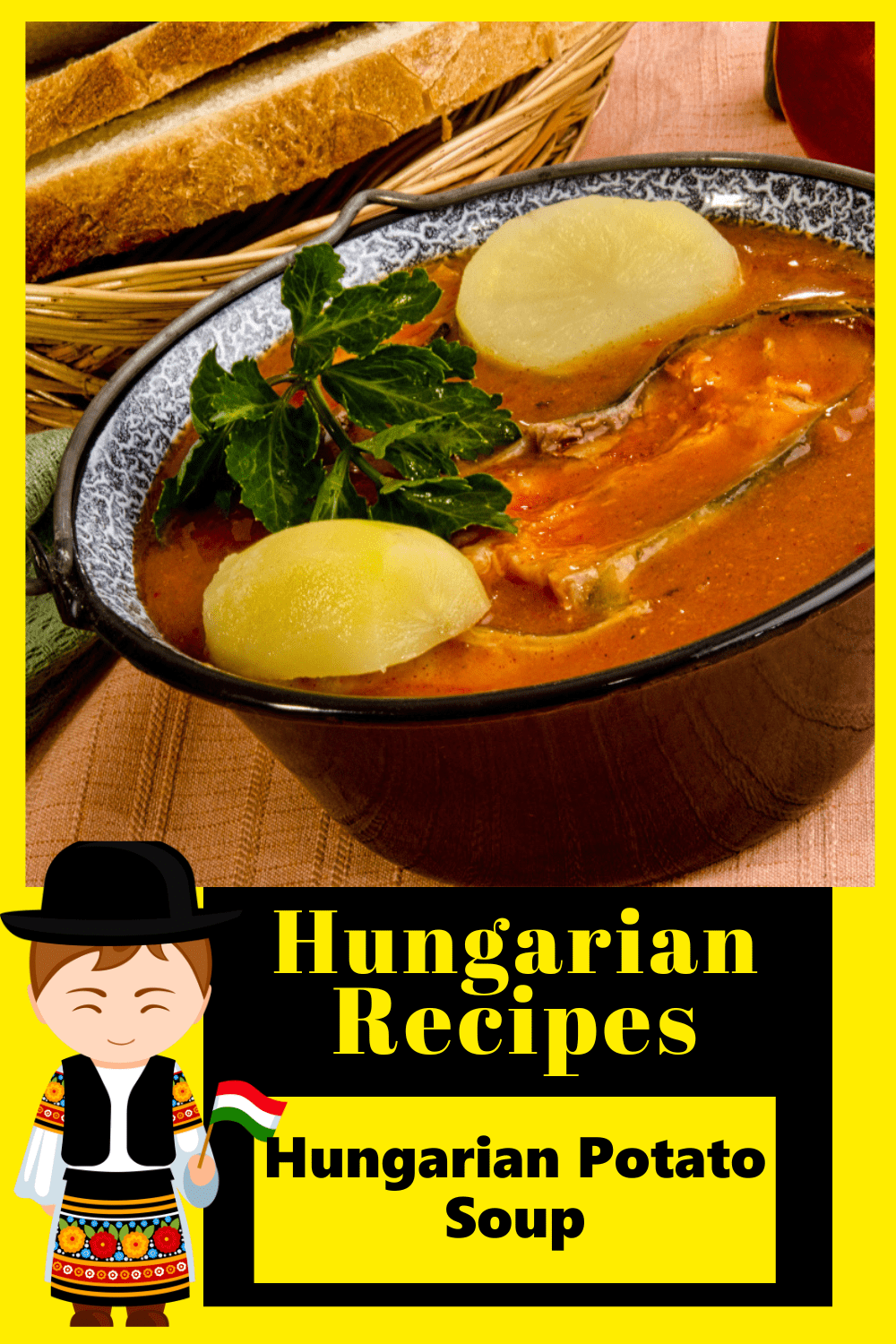
24 Easy Hungarian Food Recipes from Goulash to Hungarian Desserts
check out our video
1. Pörkölt (Beef & Onion Stew) – Hungarian Food
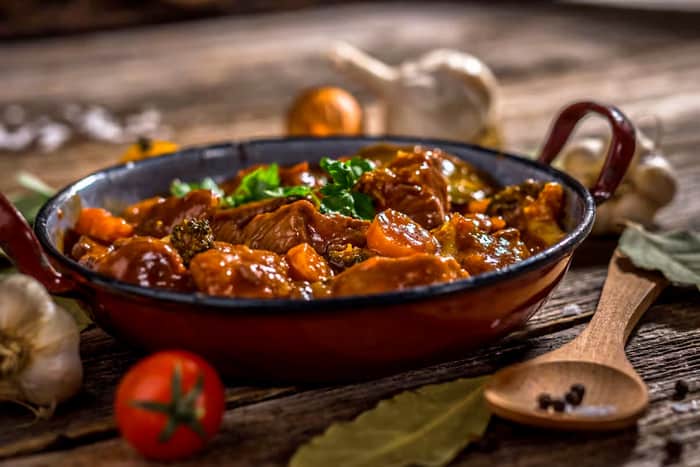
Pörkölt is Hungary’s national stew, its name derived from the word pörkölni, meaning to roast or singe. The stew is made from meat such as beef, lamb, pork, or chicken, simmered in a red sauce with lots of onions, garlic, and paprika powder.
It is traditionally served with dumplings, boiled potatoes, or pasta, and it is recommended to pair it with a Hungarian fruit brandy. Pörkölt’s history is closely linked to the traditional Hungarian goulash, as both dishes were originally prepared as peasant meals that made hefty use of powdered paprika.
2. Gulyás (Goulash) – Hungarian Recipes
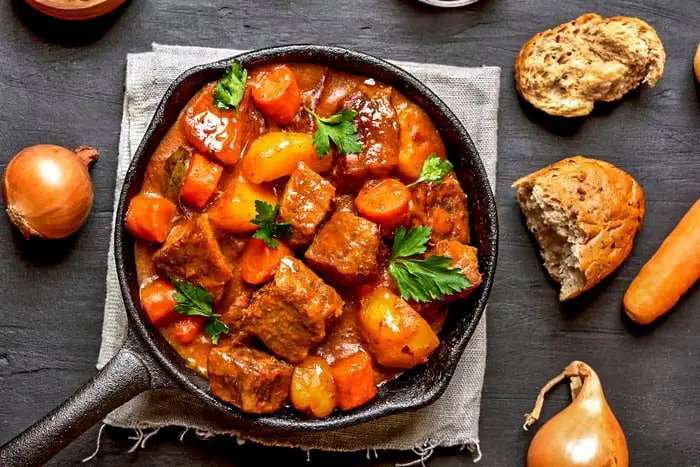
This Hungarian specialty is prepared with meat, traditionally beef, that is simmered in a rich paprika-infused broth, usually alongside onions, bell peppers, root vegetables, various spices, and occasionally tomatoes (in some regional variations).
Gulyás is a well-known dish that enjoys immense popularity even outside the Hungarian borders. In many countries, the word is synonymous with a thick stew, while in Hungary gulyás mostly represents a soup-like dish. It closely resembles pörkölt—a thick Hungarian stew consisting of meat, onions, and selected spices—which is what most people outside of Hungary associate with the word gulyás (goulash).
They both originated as traditional, rustic dishes that appeared in their modern-day form in the 18th century when paprika became a commonly used spice. In Hungary, gulyás is traditionally served accompanied by csipetke pasta or bread and is mainly enjoyed as a hearty main course.
3. Vadas Marha – Hungarian Dishes
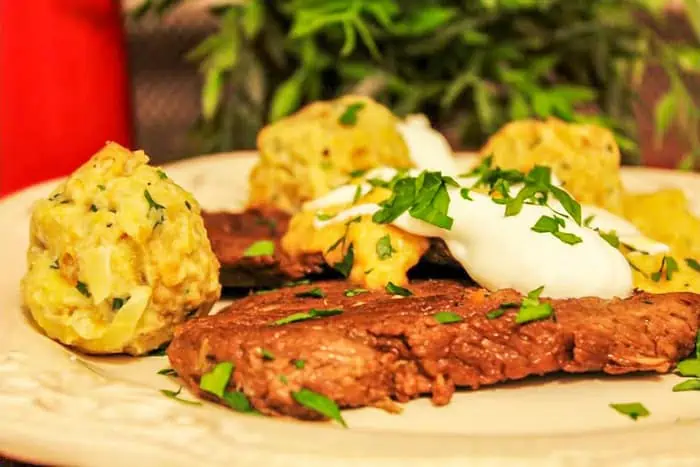
Vadas marha is a traditional dish originating from Hungary. The dish is made with a combination of sliced beef and vadas, a creamy sauce consisting of carrots, onions, parsley, bay leaves, black pepper, and sour cream. The preparation of the dish takes a long time because the beef first needs to be cooked with the vegetables and spices for 3 hours and is marinated for 24 hours.
After that, the meat is separated and cut into thick slices, and the rest of the marinade is used as a basis for the vadas sauce. Vadas marha is often served with bread dumplings on the side.
4. Túrógombóc (Hungarian Cheese Dumplings) – Hungarian Cuisine
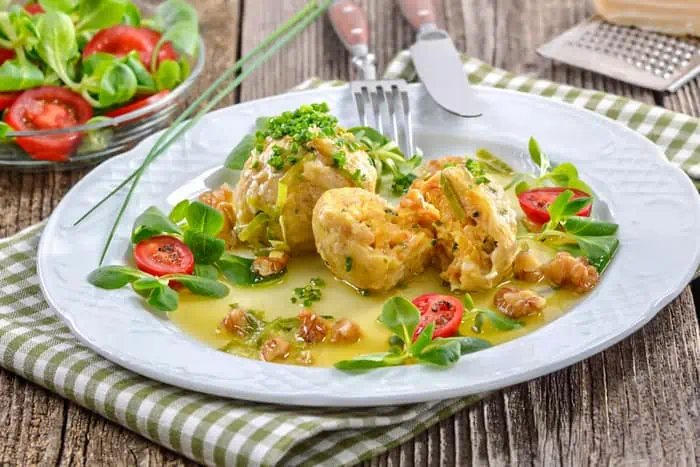
These traditional Hungarian dumplings are made with a combination of túró cheese, semolina, and eggs. The mixture is shaped into round balls that are coated in bread crumbs and fried until crispy. Even though they are often listed as a dessert, cheese dumplings are not overly sweet and can also be enjoyed as a filling main course.
If served as a dessert, they are usually accompanied by sour cream, fruit, and a dusting of powdered sugar. In Austria and Germany, similar dish goes under the name of topfenknödel.
5. Hurka – Traditional Hungarian Recipes
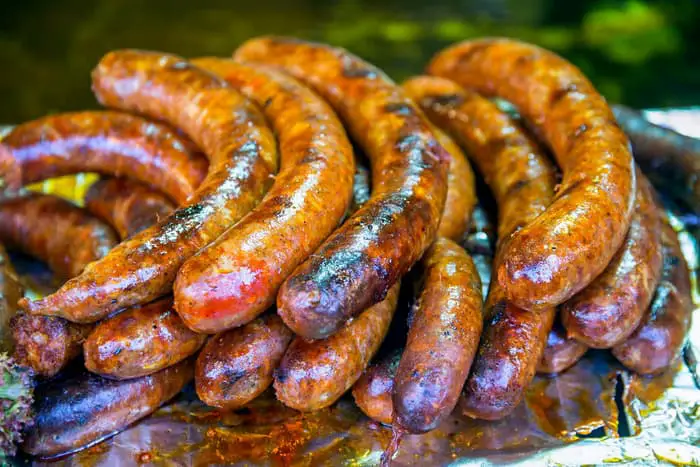
Hurka is a popular Hungarian sausage consisting of ground pork liver, lungs, rice, and onions. There are two main varieties: májas hurka, made with liver and rice, and véres hurka, made with blood, rice, and seasonings.
It is recommended to pan-fry or grill the sausages and enjoy them with fresh bread, sauerkraut, potatoes with parsley, and mustard, or alternatively, pickled vegetables such as cucumbers and peppers. Hurka pairs extremely well with a glass of cold beer on the side.
6. Hortobágyi Palacsinta (Stuffed Crepes) – Hungarian Food
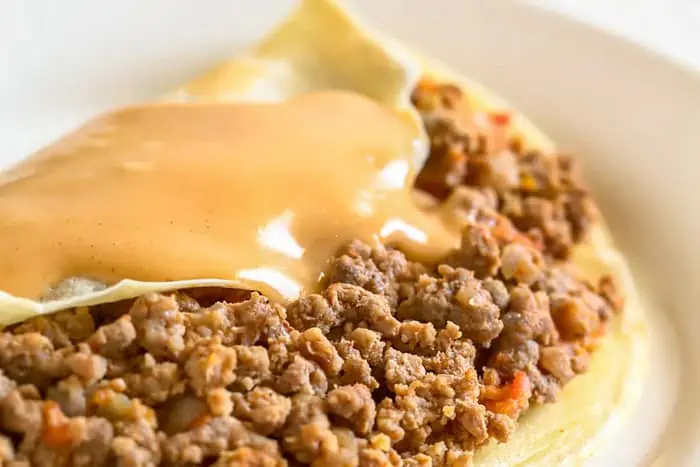
This savory pancake is a specialty of the Hungarian cuisine. It is filled with meat (typically veal) which is prepared like a stew – sautéed with tomatoes, onions, spices, and (sometimes) mushrooms. The pancakes are first filled with the combination of meat and vegetables, then tucked at the ends and baked in the oven with sour cream and paprika. After the baking, the dish is usually garnished with chopped parsley.
7. Stefánia Szelet (Stefánia Meatloaf) – Hungarian Recipes
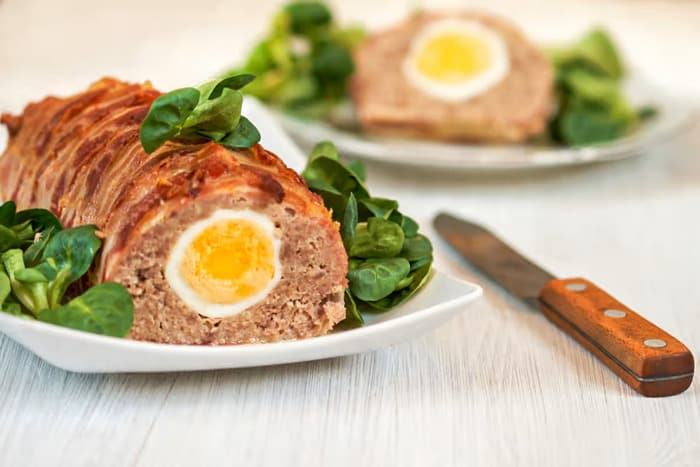
Stefánia szelet is a traditional Hungarian meatloaf stuffed with hard-boiled eggs in the middle, making the dish visually attractive once cut and the cross-section becomes visible. The meat mixture consists of ground pork, onions, garlic, caraway, paprika, parsley, and marjoram.
Instead of being fried in the pan, the meatloaf is baked in a loaf pan. When baked and sliced, the dish is often accompanied by boiled potatoes, but it can also be served on its own when it cools down a bit.
8. Sólet – Hungarian Dishes
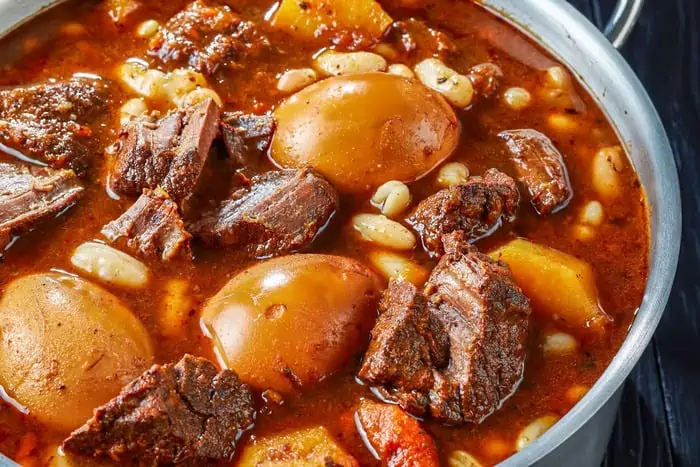
Often considered to be the predecessor to cholent, sólet is a Hungarian-Jewish stew that is traditionally slowly cooked on Friday night before the Sabbath. The stew consists of beans, paprika, onions, boiled eggs, and meat such as smoked pork, duck, beef, or goose. The next day, this hearty and nutritious stew is ready to be consumed.
9. Töltött Paprika (Hungarian Stuffed Peppers) – Hungarian Cuisine
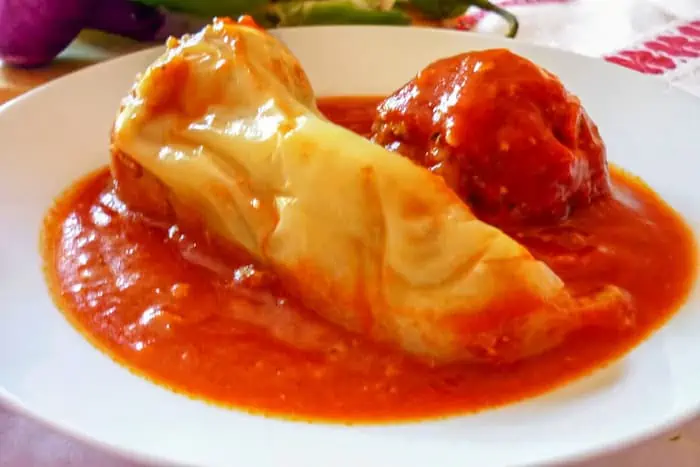
Traditionally prepared with yellow wax peppers, this Hungarian summer classic is both a common restaurant dish and a popular home-cooked meal. The peppers are usually filled with a combination of minced meat, rice, eggs, and different seasonings before they are cooked in a rich, paprika-infused tomato broth.
Stuffed peppers are always served doused in the accompanying broth and are usually enjoyed complemented by mashed potatoes or bread.
10. Töltött Kaposzta (Hungarian Stuffed Cabbage) – Traditional Hungarian Recipes

Hungarian stuffed cabbage consists of blanched fresh or sour cabbage leaves that are stuffed with a flavorful mixture of minced pork, onions, rice, and seasonings. Neatly tucked rolls are layered with sliced sauerkraut and slowly cooked. Traditionally, stuffed cabbage is cooked alongside smoked meat, and it can be slowly baked in the oven or cooked on the stovetop.
Often thickened with paprika-spiced roux and served topped with sour cream, these tender rolls are traditionally associated with Christmastime and are often served on other festive and special occasions.
11. Birkagulyás (Mutton Goulash) – Hungarian Food
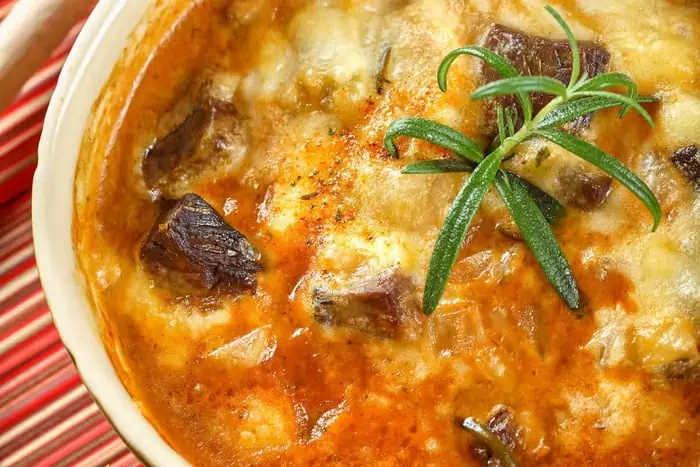
Birkagulyás is a version of a traditional Hungarian goulash prepared with mutton as the key ingredient. The mutton is cooked in a mix of vegetables such as carrots, onions, garlic, tomatoes, potatoes, and celery. The combination is usually flavored with parsley, paprika, black pepper, salt, and caraway seeds.
Some recipes also suggest the inclusion of red wine sauce to the mix. Birkagulyás, a delicious Hungarian comfort food, can be served with dumplings, sour cream, or spätzle noodles.
12. Spätzle – Hungarian Recipes
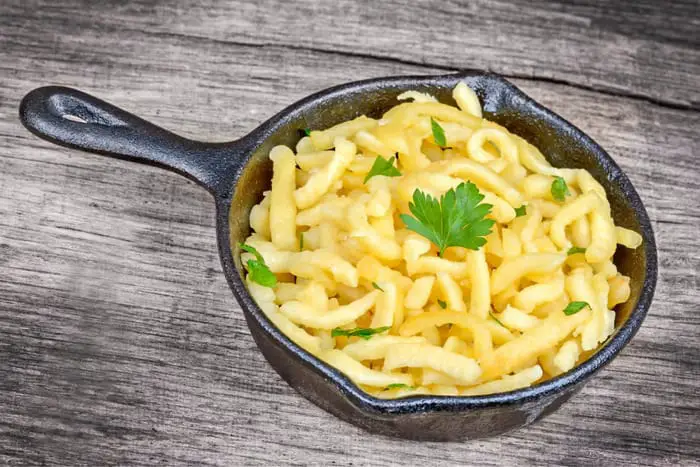
Spätzle is the German answer to pasta: thick noodles made from water, salt, flour, and eggs. They are very moist and have a soft texture, so it is not possible to roll them out – instead, they are shaped by hand, with a knife, or pressed through a variety of spätzle-presses.
The raw noodles are placed in boiling water and are finished as soon as they float up to the top. The first written recipe for spätzle dates back to 1725, although it is still not known who invented them. Spätzle are used in a variety of dishes and can be combined with ingredients such as cheese, lentils, sausages, sauerkraut, butter, and spinach.
13. Rakott Krumpli (Hungarian Potato Casserole) – Hungarian Dishes
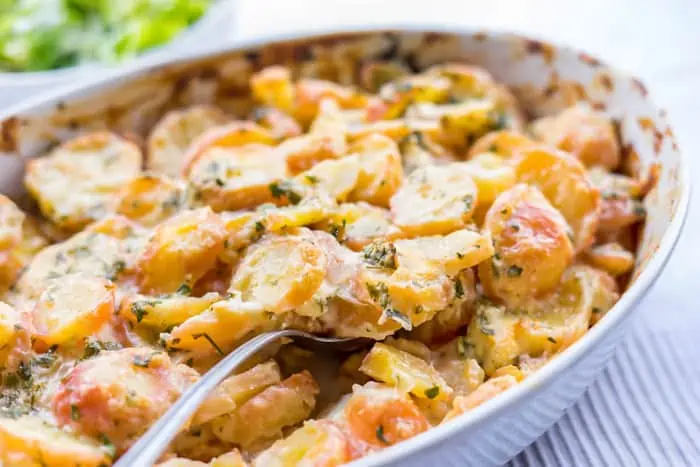
Often described as the ultimate comfort food, this traditional casserole is one the most popular Hungarian dishes. Even though it is incredibly versatile, it usually consists of multiple layers of sliced potatoes, fried bacon, or csabai sausage intertwined with a creamy mixture of eggs and sour cream.
Shortly baked until golden brown and crispy, this hearty dish is usually enjoyed as the main course and it is commonly complemented with various pickled salads.
14. Paprikás Csirke (Paprika Chicken) – Hungarian Cuisine
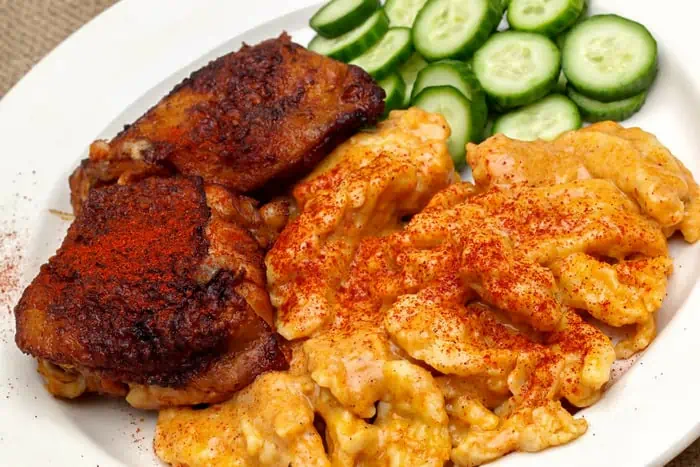
Hungarian chicken paprikás originated as a rustic stew that was cooked in a large cauldron over an open fire. It is traditionally prepared with chicken thighs and legs that are braised alongside onions and cooked in a thick, paprika-flavored broth.
Although it is similar to the classic pörkölt stew, paprikás is characterized by the addition of sour cream and occasionally flour, which are always added last to create a smooth, creamy sauce. Paprikás is a common restaurant dish as well as a hearty home-cooked meal that is traditionally served complemented by galuska or csipetke dumplings, pasta, boiled potatoes, or polenta.
15. Meggyleves – Traditional Hungarian Recipes

This sweet chilled soup made with sour cherries and sour cream is a traditional Hungarian summertime dish. Also known as hideg meggyleves, meggykeszőce or cseresznyeleves, it is prepared throughout the country as soon as cherries come into season.
Although one might be tempted to eat it as a dessert, in Hungary, this tart and creamy soup is generally served before the main course, as it makes for a refreshing alternative to the standard meat and starch fare.
16. Pogácsa – Hungarian Food
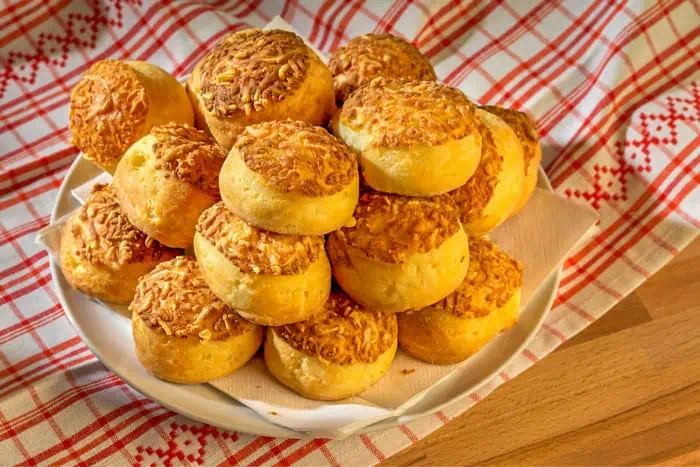
Pogácsa is a popular Hungarian snack consisting of a small, bite-sized pastry that can be either sweet or savory. Preferably, it should be eaten while still hot. Although there are differences in size and flavor, all pogácsa pastries are commonly prepared in a round shape.
Their diameter may vary from that of a thimble to that of a drinking tumbler. There are numerous varieties of pogácsa – cheese, cabbage, potatoes, bacon, and pumpkin seeds, to name a few. In Hungarian folk tales, the main hero always takes a pogácsa baked in embers as food for his adventures and long journeys, which is a strong testament to the Hungarians’ love for these traditional snacks.
17. Lecsó (Tomato-Pepper Stew) – Hungarian Recipes
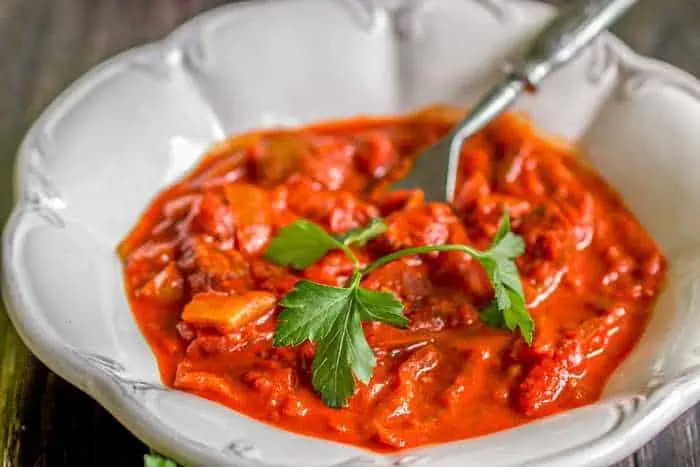
This hearty Hungarian vegetable ragout is made with a base of rendered lard or bacon fat, fried Hungarian wax peppers, tomatoes, onions, ground paprika, salt, and sometimes garlic. Lecsó can be eaten on its own with bread or with a side of rice for lunch, but it can also be served as an accompaniment to meat mains such as pork schnitzel or roasted chicken.
Lecsó itself is much akin to the French ratatouille, and though this versatile dish is prepared in numerous variations, it is said that the very best lecsó is cooked over an open fire in a bogrács, the traditional Hungarian cast iron cauldron.
18. Halászlé (Fisherman’s Soup) – Hungarian Dishes
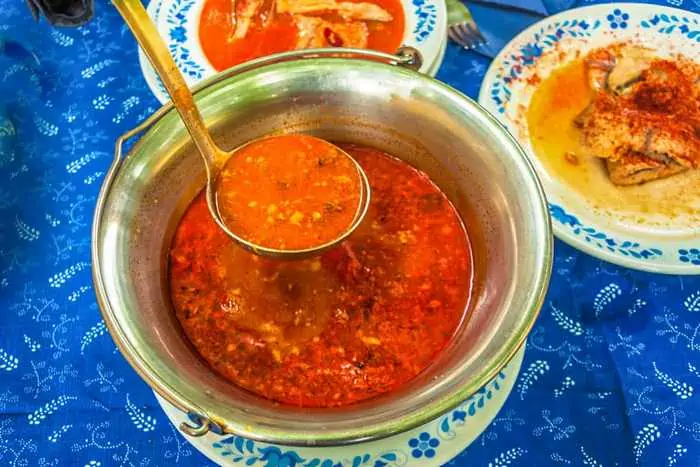
Halászlé or fisherman’s soup is made with mixed river fish cooked in a broth that is heavily spiced with hot paprika. The fish—mainly carp, catfish, perch, or pike—is locally sourced from the Tisza and Danube rivers, and though halászlé may seem like a simple dish, this rich soup is traditionally prepared outside and cooked in a kettle over an open fire.
Every region has their own version, but the two most popular are Szeged halászlé, made with four types of fish, and Baja halászlé, made mainly with carp and served with homemade pasta called gyufatészta.
19. Gulyásleves (Herdsman Soup) – Hungarian Cuisine
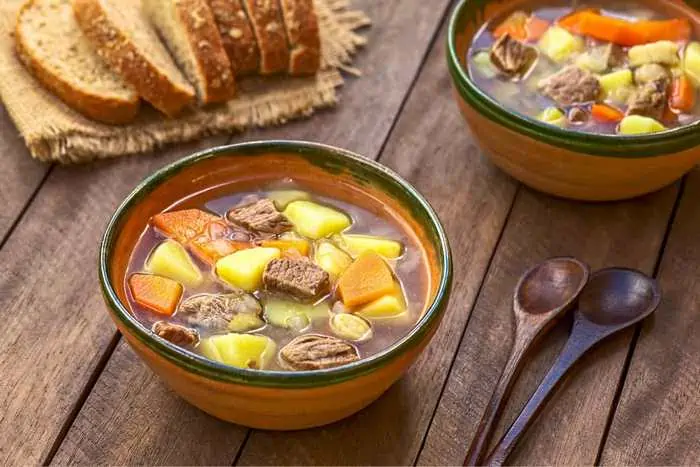
Gulyásleves is a popular Hungarian soup containing beef cubes, smoked bacon, carrots, potatoes, tomatoes, onions, paprika, pepper, and caraway seeds. Translated as herdsman soup, it can be traced back to the old nomadic tribe called Magyars, who used to cook it in big cauldrons (called bogrács) over an open fire.
Over the years, this typical Hungarian food has evolved and was adapted to make new dishes such as pörkölt and paprikás csirke (chicken paprikash). Today, there are as many recipes and variations of gulyásleves as there are Hungarian grandmothers.
20. Kifli – Traditional Hungarian Recipes
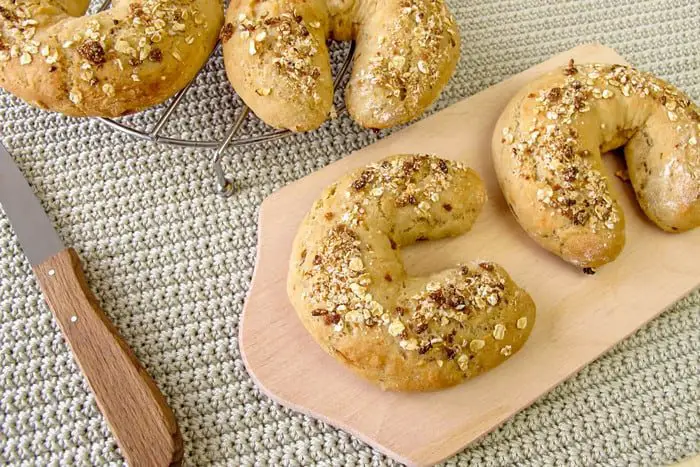
Kifli are crescent-shaped yeast rolls that can either be consumed plain, sprinkled with poppy, sesame, or caraway seeds, or topped with fruit jam or honey. Although not much is known about the origin of kifli, there is a legend saying that kifli were invented when Christians defended Buda from the Ottomans, and as a sign of celebration, the city bakers started selling fresh bread rolls in the shape of a crescent moon. Today, kifli are traditionally baked for Christmas in Hungary.
21. Dobos Torte – Hungarian Desserts
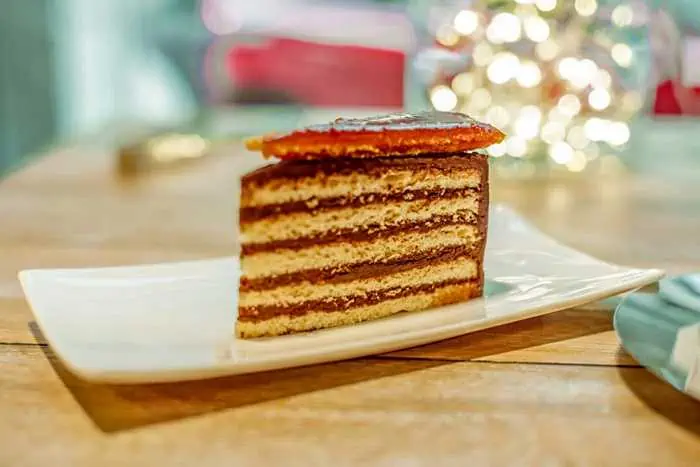
As an attempt to make a cake that would be able to keep longer than usual, the Hungarian confectioner named József C. Dobos first introduced the Dobos torte at the National General Exhibition of Budapest in 1885. It is a round cake consisting of six thin sponge cake layers and five layers of chocolate buttercream.
To prevent it from drying out, the cake also has a glistening layer of hard caramel on top, while the sides are often coated with ground nuts. Before it hardens, the layer of caramel should be cut into slices with a special Dobos knife, and the pieces of caramel are then arranged on top of the cake.
22. Krémes – Hungarian Desserts
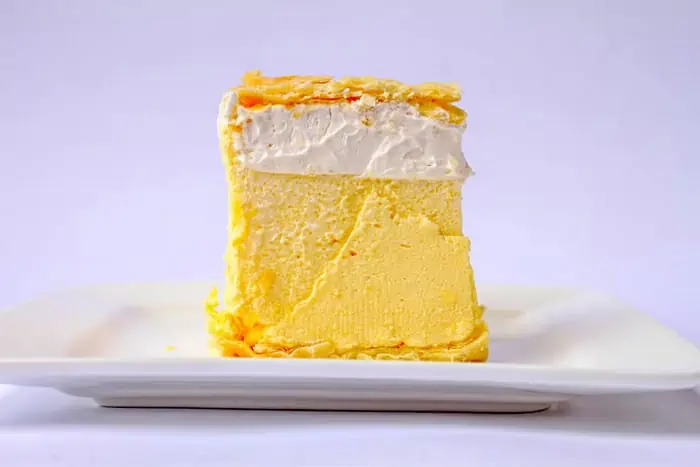
The Hungarian version of the famous cremeschnitte goes under the name krémes, meaning creamy. It combines two layers of puff pastry held together with a generous amount of smooth pastry cream. Though the recipe has been slightly modernized, the classic krémes pastry cream should be light and airy, while the top is usually dusted with powdered sugar.
Traditionally served cut into large, rectangular slices, the dessert is a Hungarian classic and a staple at numerous pastry shops throughout the country.
23. Esterházy Torta – Hungarian Desserts
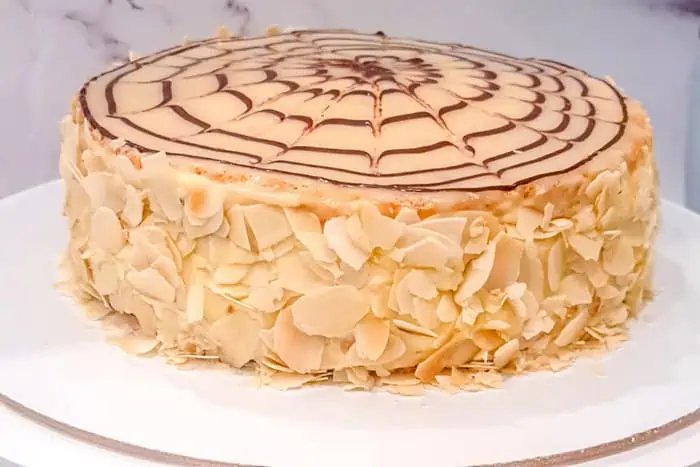
This decadent and popular Hungarian food is said to have been invented by Budapest confectioners in the 19th century. It is named after a member of the Esterházy dynasty, Prince Paul III Anton Esterházy de Galántha, a nobleman and diplomat, and also a well-known gourmand.
Traditionally, Esterházy torta consists of several layers of almond meringue and a rich, cognac-spiked vanilla buttercream, although in modern versions almonds are often replaced with either walnuts or hazelnuts. The cake is topped with a white fondant icing and decorated with chocolate in either a spiderweb or chevron marbling style.
24. Zserbó – Hungarian Dessert
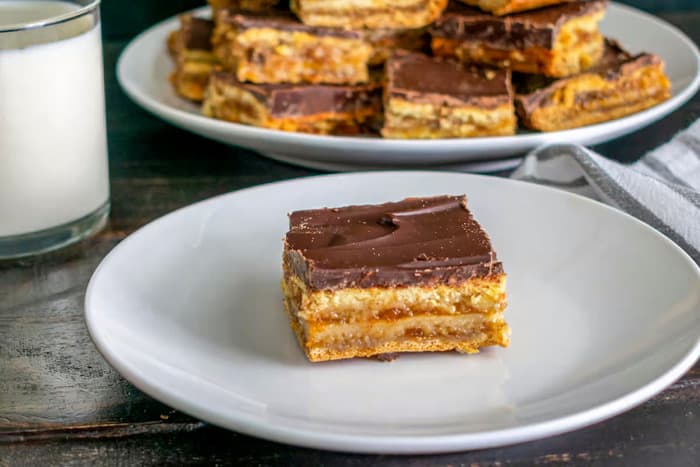
This layered, chocolate-topped apricot and walnut cake was invented by a Swiss chocolatier named Émile Gerbeaud—pronounced zserbó in Hungarian, hence the name—who moved to Budapest in 1884 to take charge of Kugler coffee house and pâtisserie, which is now the famous Café Gerbeaud.
Soon after it was introduced, the delicious zserbó cake became a favorite all over Hungary. And although the original recipe calls for apricot preserve, it is not unusual to find other versions filled with ginger, apples, plum jam, or even honey and walnuts. In other words, Zserbi us a famous Hungarian food.
You May Want to Join Our Boondocking Group on Facebook For More Information
You May Want to Join Our Campfire Recipes Group on Facebook For More Information
For More Photos Visit Our Instagram at World Recipes Daily – Our Big Escape
